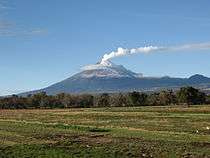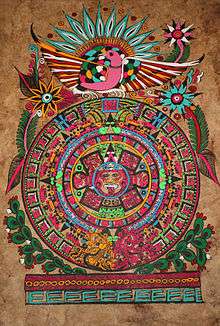Aztec calendar stone
| Sun Stone | |
|---|---|
|
| |
| Material | Basalt |
| Discovered | 17 December 1790 at El Zócalo, Mexico City |
| Present location | National Anthropology Museum, Mexico City |
The Aztec calendar stone is a late post-classic Mexica sculpture housed in the National Anthropology Museum in Mexico City, and is perhaps the most famous work of Aztec sculpture.[1] The stone is 358 centimetres (141 in) in diameter and 98 centimetres (39 in) thick, and it weighs about 24 short tons (21.4 long tons; 21.8 t).[2] Shortly after the Spanish conquest, the monolithic sculpture was buried in the Zócalo, the main square of Mexico City. It was rediscovered on December 17, 1790 during repairs on the Mexico City Cathedral.[3][4] Following its rediscovery, the calendar stone was mounted on an exterior wall of the Cathedral, where it remained until 1885.[5] Most scholars think that the stone was carved some time between 1502 and 1521, though some believe that it is several decades older than that.[6]
Physical description
.jpg)
The sculpted motifs that cover the surface of the stone refer to central components of the Mexica cosmogony.
Central disk
In the center of the monolith is the face of the solar deity, Tonatiuh,[7] which appears inside the glyph for "movement" (Nahuatl: Ōllin), the name of the current era. The central figure is shown holding a human heart in each of his clawed hands, and his tongue is represented by a stone sacrificial knife (Tecpatl).
Four previous suns or eras
The four squares that surround the central deity represent the four previous suns or eras, which preceded the present era, 4 Movement (Nahuatl: Nahui Ōllin). The Aztecs changed the order of the suns and introduced a fifth sun named 4 Movement after they seized power over the central highlands.[8] Each era ended with the destruction of the world and humanity, which were then recreated in the next era.
- The top right square represents 4 Jaguar (Nahuatl: Nahui Ōcēlotl), the day on which the first era ended, after having lasted 676 years, due to the appearance of monsters that devoured all of humanity.
- The top left square shows 4 Wind (Nahuatl: Nahui Ehēcatl), the date on which, after 364 years, hurricane winds destroyed the earth, and humans were turned into monkeys.
- The bottom left square shows 4 Rain (Nahuatl: Nahui Quiyahuitl). This era lasted 312 years, before being destroyed by a rain of fire, which transformed humanity into turkeys.
- The bottom right square represents 4 Water (Nahuatl: Nahui Atl), an era that lasted 676 years and ended when the world was flooded and all the humans were turned into fish.
Placed among these four squares are three additional dates, 1 Flint (Tecpatl), 1 Rain (Atl), and 7 Monkey (Ozomahtli), and a Xiuhuitzolli, or ruler's turquoise diadem, glyph. It has been suggested that these dates may have had both historical and cosmic significance, and that the diadem may form part of the name of the Mexica ruler Moctezuma II.[9]
Interpretation
 | |
|
|
The exact purpose and meaning of the Calendar Stone are unclear. Archaeologists and historians have proposed numerous theories, and it is likely that there are several aspects to its interpretation.[10]
The earliest interpretations of the stone relate to its use as a calendar. In 1792, two years after the stone's unearthing, Mexican anthropologist Antonio de León y Gama wrote a treatise on the Aztec calendar using the stone as its basis.[11] Some of the circles of glyphs are the glyphs for the days of the month.[10] The four symbols included in the Ollin glyph represent the four past suns that the Mexica believed the earth had passed through.[12]
Another aspect of the stone is its religious significance. One theory is that the face at the center of the stone represents Tonatiuh, the Aztec deity of the sun. It is for this reason that the stone became known as the "Sun Stone." Richard Townsend proposed a different theory, claiming that the figure at the center of the stone represents Tlaltecuhtli, the Mexica earth deity who features in Mexica creation myths.[10] Modern archaeologists, such as those at the National Anthropology Museum in Mexico City, believe it is more likely to have been used primarily as a ceremonial basin or ritual altar for gladiatorial sacrifices, than as an astrological or astronomical reference.[5]
Yet another characteristic of the stone is its possible geographic significance. The four points may relate to the four corners of the earth or the cardinal points. The inner circles may express space as well as time.[13]
Lastly, there is the political aspect of the stone. It may have been intended to show Tenochtitlan as the center of the world and therefore, as the center of authority.[14] Townsend argues for this idea, claiming that the small glyphs of additional dates amongst the four previous suns—1 Flint (Tecpatl), 1 Rain (Atl), and 7 Monkey (Ozomahtli)—represent matters of historical importance to the Mexica state. He posits, for example, that 7 Monkey represents the significant day for the cult of a community within Tenochtitlan. His claim is further supported by the presence of Mexica ruler Moctezuma II's name on the work. These elements ground the Stone's iconography in history rather than myth and the legitimacy of the state in the cosmos.[15]
Modern use

The calendar stone image is displayed on the obverse the Mexican 20 Peso gold coin, which has a gold content of 15 grams (0.4823 troy ounces) and was minted from 1917-1921 and restruck with the date 1959 from the mid 1940s to the late 1970s. As of October 2015 its value was roughly $600. Different parts of the calendar are represented on the current Mexican coins, each denomination has a different section.
The calendar stone image also has been adopted by modern Mexican and Mexican American/Chicano culture figures, and is used in folk art and as a symbol of cultural identity.[16]
See also
Notes and references
References
- ↑ National Anthropology Museum, Mexico City, "Sun Stone"
- ↑ The Aztec Sun Stone
- ↑ Florescano, Enrique (2006). National Narratives in Mexico. Nancy T. Hancock (trans.), Raul Velasquez (illus.) (English-language edition of Historia de las historias de la nación mexicana, ©2002 [Mexico City:Taurus] ed.). Norman: University of Oklahoma Press. ISBN 0-8061-3701-0. OCLC 62857841.
- ↑ Aztec Civilization
- 1 2 Getty Museum, "Aztec Calendar Stone" getty.edu, accessed 22 August 2018
- ↑ Villela, Khristaan. "The Aztec Calendar Stone or Sun Stone", MexicoLore. Retrieved December 17, 2015.
- ↑ The public description by the National Anthropology Museum assigns the face to the fire god, Xiuhtecuhtli.
- ↑ Villela, Khristaan; Michel Graulich (2010). "The Stone of the Sun". The Aztec Calendar Stone. Los Angeles: Getty Research Institute. p. 258.
- ↑ Umberger, Emily. "The Structure of Aztec History". Archaeoastronomy IV, no. 4 (Oct-Dec 1981): 10–18.
- 1 2 3 K. Mills, W. B. Taylor & S. L. Graham (eds), Colonial Latin America: A Documentary History, 'The Aztec Stone of the Five Eras', p. 23
- ↑ Antonio de León y Gama: Descripción histórica y cronológica de las dos piedras León y Gama
- ↑ Townsend, Casey (1979). State and Cosmos in the Art of Tenochtitlan. Washington, DC: Dumbarton Oaks.
- ↑ K. Mills, W. B. Taylor & S. L. Graham (eds), Colonial Latin America: A Documentary History, 'The Aztec Stone of the Five Eras', pp. 23, 25
- ↑ K. Mills, W. B. Taylor & S. L. Graham (eds), Colonial Latin America: A Documentary History, 'The Aztec Stone of the Five Eras', pp. 25-6
- ↑ Townsend, Richard Fraser (1997-01-01). State and cosmos in the art of Tenochtitlan. Dumbarton Oaks, Trustees for Harvard University. ISBN 9780884020837. OCLC 912811300.
- ↑
Sources
- León y Gama, Antonio de. Descripción histórica y cronológica de las dos piedras: que con ocasión del empedrado que se está formando en la plaza Principal de México, se hallaron en ella el año de 1790. Impr. de F. de Zúñiga y Ontiveros, 1792. An expanded edition, with descriptions of additional sculptures (like the Stone of Tizoc), edited by Carlos Maria Bustamante, published in 1832. There have been a couple of facsimile editions, published in the 1980s and 1990s.
- Matos Moctezuma, Eduardo, and Felipe Solís. The Aztec Calendar and other Solar Monuments. Grupo Azabache, Mexico. 2004.
- Mills, K., W. B. Taylor & S. L. Graham (eds.), Colonial Latin America: A Documentary History, 'The Aztec Stone of the Five Eras'
- Solis, Felipe. "La Piedra del Sol." Arqueologia Mexicana 7(41):32-39. Enero - Febrero 2000.
- Villela, Khristaan D., and Mary Ellen Miller (eds.). The Aztec Calendar Stone. Getty Publications, Los Angeles. 2010. (This is an anthology of significant sources about the Calendar Stone, from its discovery to the present day, many presented in English for the first time.)
- Umberger, Emily. "The Structure of Aztec History." Archaeoastronomy IV, no. 4 (Oct-Dec 1981): 10-18.
External links
| Wikimedia Commons has media related to Aztec sun stone. |
| Wikisource has original text related to this article: |
- Mysteries of the Fifth Sun: The Aztec Calendar
- Introduction to the Aztec Calendar
- The Aztec Sun Stone
- The Sun Stone
- The Aztec Sunstone Calendar
- Library of Congress digital edition of Leon y Gama's 1792 work on the Calendar Stone (72MB)
Coordinates: 19°25′34″N 99°11′15″W / 19.42611°N 99.18750°W